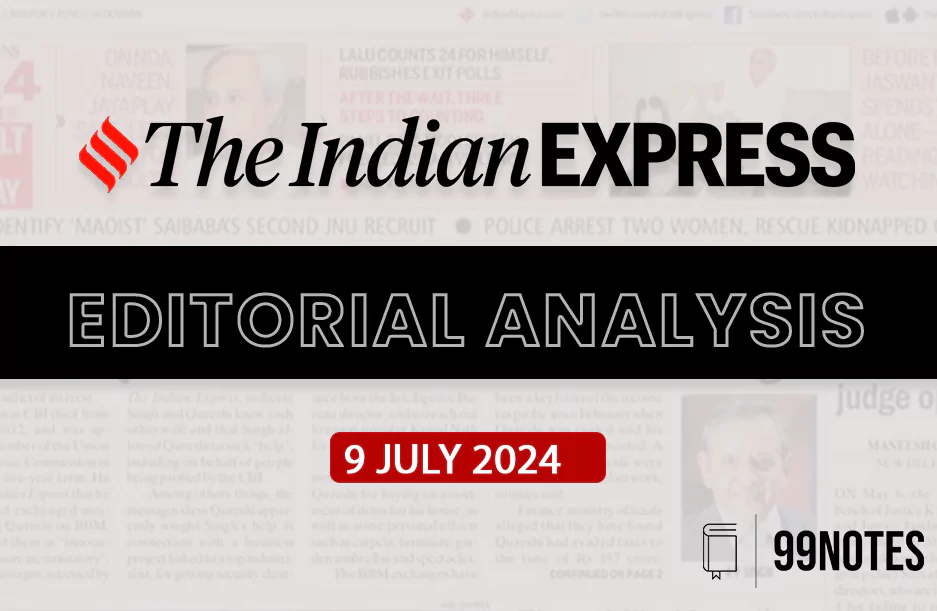9 July 2024 : Indian Express Editorial Analysis
1. TRADE POLICY NEEDS A RESET
(Source: Indian Express; Section: The Editorial Page; Page: 10)
| Topic: GS2– International Relations – Important International institutions, agencies and fora – their structure, mandate. |
| Context: |
|
World Trade Organisation (WTO)
- The World Trade Organization (WTO) is the only global international organization dealing with the rules of trade between nations.
- At its heart are the WTO agreements, negotiated and signed by the bulk of the world’s trading nations and ratified in their parliaments.
- The WTO has 164 members (including European Union) and 23 observer governments (like Iran, Iraq, Bhutan, Libya etc).
Global Economic Governance and India’s Role
- The reshaping of global economic governance in a world influenced by geoeconomics, emerging technologies, resilient global value chains, and environmental sustainability presents both challenges and opportunities for India.
- As a rising economy, India has significant stakes in this new paradigm. While achieving a new equilibrium of global rules will involve friction, India’s growing global stature necessitates a constructive role in managing differences amidst changing dynamics.
- India’s domestic policy reforms aim to foster technology-driven and environmentally sustainable economic growth, integrating more deeply into the global economy.
India’s Economic Strategy and Performance
- India’s economic strategy has positioned it as a favored destination for global investors, ranking third in attracting Foreign Direct Investment (FDI) in 2022, after the US and China.
- The country aims to boost goods exports to $1 trillion by 2030, establishing itself as a manufacturing powerhouse. Additionally, its e-commerce market is projected to reach $350 billion by 2030.
- Despite the current e-commerce routed exports constituting only 1% of total exports, the global potential offers substantial growth opportunities.
- India’s regulatory reforms have been pivotal in promoting digitization, transparency, and operational efficiency, fostering a conducive environment for e-commerce enterprises.
Policy Reforms and Environmental Commitments
- India’s policy reforms in areas such as data protection, consumer rights, competition, and taxation align with global standards, enhancing the ecosystem for e-commerce.
- The country’s commitment to a low-carbon, resilient, and equitable transition is reflected in its pledge to achieve net zero carbon emissions by 2070, along with significant achievements in improving energy access and reducing greenhouse gas emissions.
- In its export-led growth model, India emphasizes the importance of pursuing policy predictability in key destination markets such as the US, the European Union, Japan, and other emerging economies, particularly in high-technology sectors.
Historical Context and Current Imperatives
- The historical context that initially shaped India’s strategy differs significantly from today’s landscape. The policy reforms initiated in the wake of the 1991 economic crisis dismantled trade barriers, attracted foreign investments, and fueled economic expansion.
- Currently, India must adeptly manage its growth trajectory by emphasizing digitization, sustainable development, and resilient value chains to bolster its manufacturing sector.
- Seeking international consensus on rules and disciplines related to emerging economic issues and navigating the evolving geo-economic landscape is in the country’s best interest.
Importance of WTO Participation
- India’s active participation in WTO discussions is crucial for successful bilateral engagement with major markets and for building a leadership position in the Global South.
- The lack of engagement has not deterred other nations from forming a consensus on new regulations in disruptive technologies or unilateral carbon border adjustment measures that could harm Indian business interests.
- Moving forward, India needs to break away from traditionally held defensive positions. With a goal of achieving ambitious export targets and accelerating GDP growth, India aims for a higher trade-to-GDP ratio.
- The country’s proactive engagement in multilateral disciplines through forums like the G20 and bilateral negotiations should extend to WTO negotiations to achieve its national economic development objectives.
Conclusion
- India’s resistance to the expansion of the WTO’s negotiation agenda stems from a desire to preserve policy flexibility for economic development. However, embracing a more proactive role in these negotiations is essential for the country’s future growth.
- By participating actively in discussions on e-commerce, trade, climate change, and investment facilitation, India can better align its development goals with global economic trends, ensuring a robust and sustainable economic future.
| What are the Solutions to Reform the WTO? |
|
Support Proposal to get New Members:
Suitable Punishment if Law is Broken:
Reformative Approach:
Regular Meeting of the Members:
Developing Countries’ Call for DSM Restoration:
Options for Developing Countries:
MPIA as an Interim Solution:
Diluted Appellate Body:
Opt-Out Provision for AB as an Interim Solution:
|
| PYQ: WTO is an important international institution where decisions taken affect countries in profound manner. What is the mandate of WTO and how binding are their decisions? Critically analyse India’s stand on the latest round of talks on Food security. (200 words/12.5m) (UPSC CSE (M) GS-2 2014) |
| Practice Question: India’s resistance to the expansion of the WTO’s negotiation agenda in areas such as e-commerce, trade, climate change, and investment facilitation has sparked significant debate. Analyze how this stance impacts India’s traditional and emerging economic sectors, and discuss the potential benefits and challenges of a more proactive engagement in WTO negotiations. (250 words/15 m) |
2. Joblessness & the skill gap
(Source: Indian Express; Section: The Ideas Page; Page: 11)
| Topic: GS3– Indian Economy – Issues relating to development and employment |
| Context: |
|
Rural Employment Guarantee Schemes
- India has accumulated experience with rural employment guarantee schemes introduced at the central level in 2005, aimed at providing manual labor to the very poor.
- However, parts of the original law remain unimplemented, such as timely unemployment benefits and wage payments. These schemes often provide less than the stipulated 100 days of work per household.
- Expanding such programs to the urban sector, as proposed by Jean Dreze’s “Decentralised Urban Employment and Training” (DUET) scheme, requires serious consideration.
- Urban employment programs could focus on improving infrastructure and environmental resources, despite the significant costs involved.
Sustainable Job Programs
- Beyond distress employment, there is a need for long-term sustainable programs offering good-quality jobs. One major issue is the low level of skills and training among the workforce.
- A large-scale vocational education program linked to apprenticeships in business firms should be implemented. Successful models from countries like Germany and the United States, as well as programs in developing countries such as Kenya and Colombia, can serve as examples.
- Coordination between firms, local governments, business associations, and civic organizations is essential for these programs to succeed.
Capital and Wage Subsidies
- India currently provides numerous capital subsidies to encourage investment, which often lead to labor-replacing, capital-intensive investments.
- It is essential to reassess these subsidies and replace many with wage subsidies, especially for large firms in the organized sector, on the condition that they create new regular jobs.
- This shift could incentivize firms to hire more workers and reduce unemployment.
Technical Assistance for Non-Farm Enterprises
- In addition to agricultural extension services, India should focus on providing technical assistance and extension services to non-farm household enterprises.
- This support could include management training and technical aid, helping these enterprises create productive jobs. Similar initiatives, like software aid to community health and caregiving workers, have shown promise and could be expanded.
Addressing Demand Deficiency
- A significant issue often overlooked in job promotion discussions is the demand deficiency faced by private investors in the mass consumer market.
- This problem is exacerbated by large income and wealth inequality, where the benefits of growth are concentrated at the top, leaving the bottom sections with stagnant wages and employment.
- Raising incomes for these lower sections would boost demand and create more jobs. Implementing a basic income supplement for all such groups, not just farmers, could achieve this.
- A modest basic income could be funded by reducing subsidies to the better-off and increasing taxes on the rich, including inheritance and wealth taxes.
Conclusion
- Addressing the urgent issue of joblessness in India requires a multifaceted approach, combining immediate relief measures with long-term sustainable job programs.
- Political courage and imagination are necessary to implement these changes and create a more equitable and prosperous economy.
- By focusing on vocational education, wage subsidies, technical assistance, and income supplements, India can create a robust job market that meets the needs of its growing population.
| What are the Major Causes of Unemployment in India? |
|
| PYQ: Most of the unemployment in India is structural in nature. Examine the methodology adopted to compute unemployment in the country and suggest improvements. (250 words/15m) (UPSC CSE (M) GS-3 2023) |
| Practice Question: Despite India’s economic growth, joblessness remains a persistent issue, particularly affecting the young population. Discuss the reasons behind the insufficient job creation in India and evaluate the effectiveness of current employment guarantee schemes. What long-term sustainable strategies can be implemented to address the job crisis? (250 words/15 m) |





